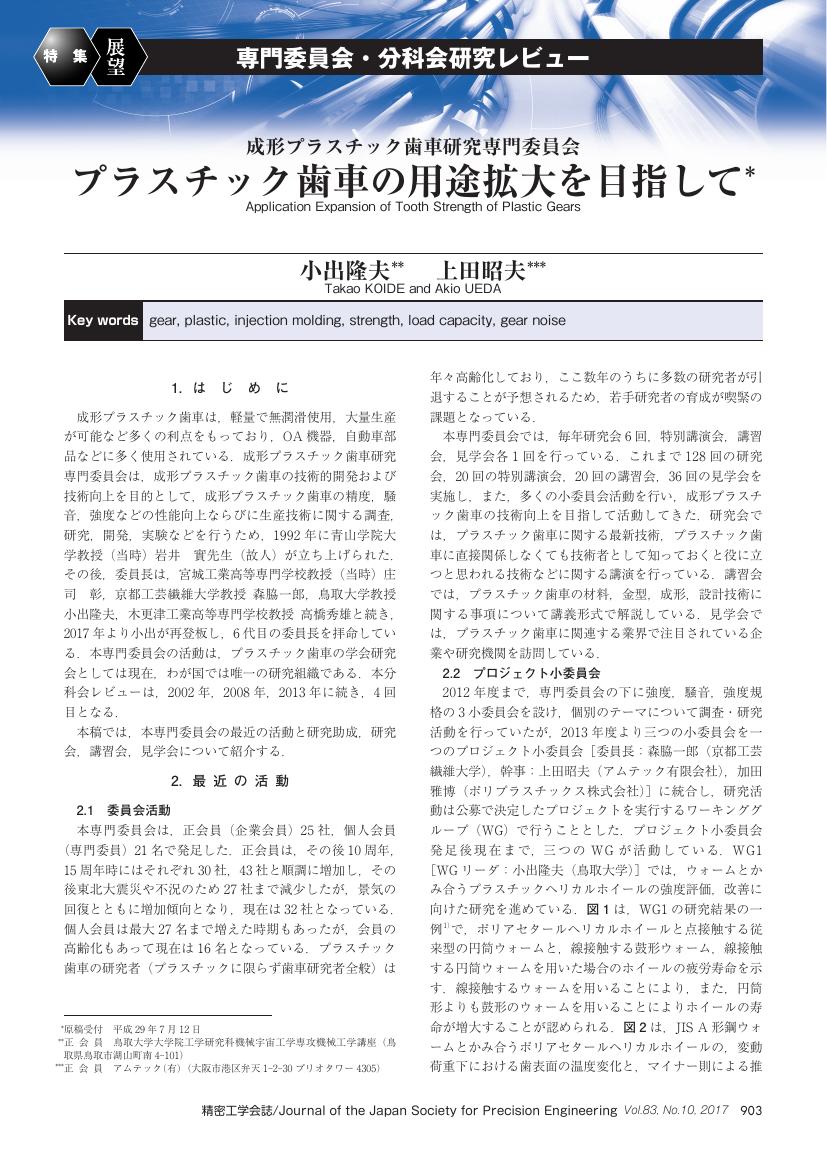1 0 0 0 OA 【成形プラスチック歯車研究専門委員会】プラスチック歯車の用途拡大を目指して
- 著者
- 小出 隆夫 上田 昭夫
- 出版者
- 公益社団法人 精密工学会
- 雑誌
- 精密工学会誌 (ISSN:09120289)
- 巻号頁・発行日
- vol.83, no.10, pp.903-906, 2017-10-05 (Released:2017-10-05)
- 参考文献数
- 4
1 0 0 0 OA 歯面膜要素を用いた動力伝達用歯車の角当たり解析
- 著者
- 森脇 一郎 上田 昭夫 射場 大輔
- 出版者
- 一般社団法人 日本機械学会
- 雑誌
- 日本機械学会論文集 (ISSN:21879761)
- 巻号頁・発行日
- vol.84, no.863, pp.18-00033, 2018 (Released:2018-07-25)
- 参考文献数
- 9
- 被引用文献数
- 1
The present paper describes edge contact analyses for power transmission gears using tooth-flank-film elements, which have been proposed for finite element analyses of tooth stresses. For edge contact analyses, the tooth-flank-film elements are placed not only on usable flanks but also over tooth edges. Finer elements on edge neighboring areas and on the parts of usable tooth flanks where tend to contact with mating edges enable the edge contact to be analyzed. Comparisons of calculated distributions of tooth contact stress with observed tooth flanks after a running test showed the validity of the proposed method for edge contact analyses.
1 0 0 0 OA 和時計から日本の歯車の源流を探る
- 著者
- 上田 昭夫 渡邉 淳 宮嵜 美弥子 久保 愛三 松岡 裕明
- 出版者
- 一般社団法人 日本機械学会
- 雑誌
- 日本機械学会論文集 (ISSN:21879761)
- 巻号頁・発行日
- vol.83, no.847, pp.16-00295-16-00295, 2017 (Released:2017-03-25)
- 参考文献数
- 18
The purpose of this study is to understand the nature of one of the oldest gears used in traditional Japanese clock. Today's gear manufacturing technology in Japan came mostly from Europe and America, but we do not know exactly, when and how the gears were manufactured for the first time in Japan. It is interesting to search for this history. It is also exciting to study the tooth profile, precision and accuracy of the gears, and materials of the gears at that time. So far, there have been some studies performed for the mechanism of traditional Japanese clocks/watches, but not for gears. Fortunately we have a chance this time to investigate gears for Japanese watch drive that was made in 1688. Tooth profile and pitch error were measured, and transmission error analysis was also performed. It revealed that the precision of the watch was extremely high without any rust for more than 300 years, even though they were all handmade by Japanese mechanism technician named Sukeza-emon Tsuda the III. In the old days, there was no study on conjugate tooth profile theory available, but mysteriously, tooth profile was nearly made in the form of cycloid. Moreover, the gear material investigation was very interesting: The texture of the gear material was very homogeneous and grain size is far smaller than that of today's comparable steel kind. Impurities in it were very small and scattered well in the matrix. The steel was surely made by Japanese sword smith. The ore of the steel was perhaps sand-iron and it was refined with pine charcoal. The steel was forged and forged by hand very hardly. As the result the quality of the steel of 1688 looks far better than today's industrial steel. This research enabled us to discover how Japanese gear technology was born and developed.
